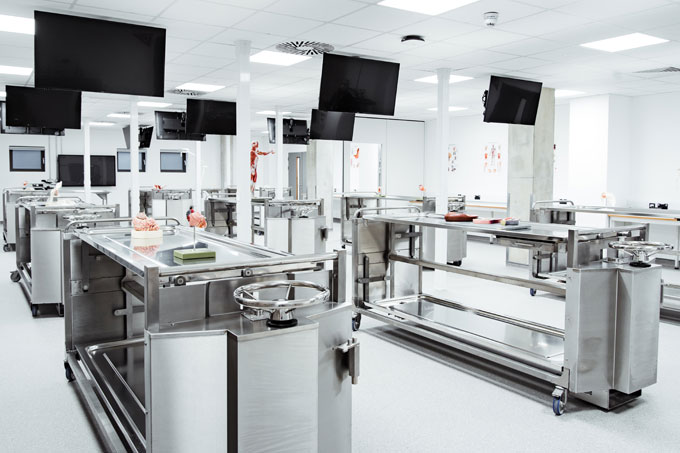Professor Chris Holland explains how the Verena Holmes Building will help support the training of new doctors in the Kent and Medway medical School.
In the midst of a pandemic, the University of Kent and Canterbury Christ Church University have achieved something amazing. Together, we have opened the Kent and Medway Medical School (KMMS), welcoming our first students, 108 future doctors.
A new medical school requires new and specialist facilities, staff and resources, and seeing this all come together has been one of the most professionally satisfying periods of my career.
Our students are now studying in wonderful state-of-the-art buildings: the Pears Building at the University of Kent and the Verena Holmes Building at Canterbury Christ Church. Between them they house the first high-fidelity simulated GP suite and the first human anatomy facility to be built in Kent and Medway.
The Anatomy Learning Centre within the new Verena Holmes Building on Christ Church’s Canterbury campus is the first of its kind in the region. It offers amazing facilities that not only allows our medical students to perform the more traditional cadaveric dissection and prosection, but also the opportunity for them to learn using integrated medical imaging such as X-rays, CTs and Ultrasound. It also uses the innovative Thiel embalming method, which is only used in a few medical schools across the country. This method retains the body’s natural look and feel which will be invaluable to our students as they learn about dissection and in time will help specialists develop surgical skills.
The Verena Holmes Building also offers our KMMS students the chance to learn alongside fellow health students, as well as students specialising in other disciplines such as engineering and sports science.
The shared health and medicine spaces, such as the High Fidelity Hospital Simulation Suite, will be invaluable in helping our medical students to learn to work in teams with other health care students. This will ensure they learn the vital communication and teamwork skills needed to be a successful doctor, and learn about the invaluable contributions made by other healthcare professionals within clinical environments.
Being co-located in a building with students and staff from other faculties will also encourage our KMMS students and colleagues to see synergies in what they are all doing with other industries and practices. Just like the amazing female engineer and medical inventor the building was named after, we hope this will lead to innovative research and developing technological solutions to help address the healthcare issues in our region.
The current pandemic has brought into sharp focus both what a wonderful institution the NHS is, and how 21st century healthcare researchers are able to mobilise a global response to a global threat and compress years of work into a few short months.
As we build our network across universities and the health and care sector of Kent and Medway both buildings will help us to develop opportunities for academic and healthcare professional colleagues to conduct high-quality research that will make a difference to patients’ lives.
These new buildings at Canterbury Christ Church and the University of Kent, and their remarkable facilities, will help to ensure our students are taught the skills needed to address healthcare issues in our region and beyond. The legacy and history of KMMS began long before the pandemic and will outlast it many times over.
Chris Holland, Professor of Medical Education, is the Founding Dean of KMMS and a Consultant in Intensive Care.
KMMS is a collaboration between Canterbury Christ Church University and the University of Kent, benefitting from the strengths and experience in both healthcare teaching and research they offer.
 Expert comment
Expert comment Jeanette Earl
Jeanette Earl 1963
1963


